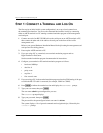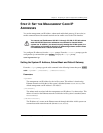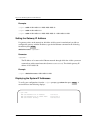
Avidia System File Management
8 Avidia System Configuration and Management User Manual
AVIDIA SYSTEM FILE MANAGEMENT
Each Avidia line, channel, and management card ships with the necessary system files
preinstalled in NVRAM (Non-Volatile Random Access Memory).
Restoring System Files
To restore system files for a card, copy a complete set of system files from the Avidia
MuxWare™ CD-ROM to that card. See “Managing Image Files” on page 354 for
command-line interface instructions or “Managing Image Files” on page 571 for Web interface
instructions.
How Image Files are Used
Each card in the Avidia system contains its own image files, which are stored in NVRAM and
have a .bin file name extension. Image files contain the firmware and software required to use
the hardware on which they reside. When you boot the Avidia system, each card runs a
bootstrap program that retrieves the image file out of NVRAM, decompresses it, then loads it
into Random Access Memory (RAM). The firmware runs from RAM during system operation.
How Configuration Files are Used
All configuration information for the Avidia system is stored permanently in the management
card NVRAM. There is a separate ASCII configuration file for each card. The files are named
SnnCxxxx.cnf, where nn is the slot number and xxxx is the part number for that card.
During system startup, each line card and channel card retrieves its configuration file from the
management card and stores the information in RAM. If the management card is not installed,
or is not functioning, the line cards and channel cards can not boot.
If you remove a line or channel card and replace it with a new card of the same type, the new
card automatically loads the previous card’s configuration file from the management card into
RAM. To configure the new card differently, use one of the management interfaces to delete the
existing configuration then configure the card as desired. If you remove a line or channel card
and replace it with a new card of a different type, the card will not load the previous
configuration file.


















